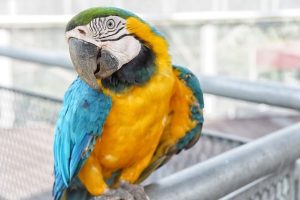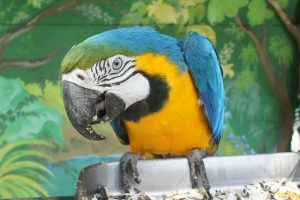A blue and yellow macaw’s average lifespan in the wild is about 30 to 35 years. However, these birds can live much longer in captivity – up to 60 years or more. This is due to the better food and medical care they receive in captivity. You will find more about the Blue and Yellow Macaw’s lifespan in the wild and captivity in this content.
However, while macaws may have a longer lifespan in captivity, blue and yellow macaws are still wild animals.
They require a lot of space to fly and exercise, and they need a diet consisting of fresh fruits, vegetables, and nuts. If you are considering getting a macaw as a pet, make sure you are prepared to provide them with everything they need to live a prosperous and happy life.
Blue and Yellow Macaw Lifespan In Wild and Captivity, at a glance:

| Color | Blue and Yellow |
| Lifespan |
|
| Size | 81 – 91 cm |
| Weight | 0.09 – 1.5 kg |
| Native Region | South and Central America |
| Foods | Seeds, nuts, and fruits |
| Sound | Like a child crying |
| Diseases |
|
Blue and Yellow Macaw Lifespan in the Wild
The Blue and Yellow Macaw is a magnificent bird with a lifespan of 30 to 35 years in the wild. It is a native of South America and is found in the tropical rainforests of Brazil, Bolivia, Peru, Ecuador, Colombia, and Venezuela.
In the wild, blue and yellow macaws typically live in pairs or small groups. They spend their days searching for food, playing, and socializing.
These birds are very active and need plenty of space to explore and fly. Their diet consists mostly of fruits, nuts, and seeds.
However, they face many challenges in rainforest homes, from habitat loss to the illegal pet trade. But they are resilient birds, and with the help of conservationists, they are slowly but surely bouncing back.
Blue and Yellow Macaw Lifespan in Captivity
The lifespan of a blue and yellow macaw in captivity can vary greatly depending on the bird’s individual health and husbandry. In general, however, these birds can live for upwards of 60 years with proper care in captivity.
One of the reasons that macaws have such a long lifespan is that they are relatively disease-resistant. Additionally, these birds are relatively hardy and can withstand many conditions.
However, it is important to note that macaws are still susceptible to certain health problems, such as obesity, if they are not properly cared for.
If you are considering getting a blue and yellow macaw, be prepared for a long-term commitment. These birds can live for many years and need proper care and attention throughout their lives.
However, the rewards of owning one of these beautiful and amazing creatures are more than worth the effort.
Factors for Shorter Lifespan in the Wild
The blue and yellow macaw is a beautiful and popular bird, but unfortunately, its lifespan in the wild is not as long as it could be. Many factors can affect the lifespan of a blue and yellow macaw in the wild. By understanding these factors, we can help give these macaws the best chance at a long and healthy life.
Factor affecting blue and yellow macaws’ lifespan in the Wild:
- Diet: blue and yellow macaws are mostly vegetarian, eating mostly fruits, nuts, and seeds.
- Predation: blue and yellow macaws are preyed on by animals such as jaguars, snakes, and hawks.
- Habitat loss: blue and yellow macaws’ habitats are being destroyed by humans for agriculture, livestock grazing, and timber production.
- Trapping: blue and yellow macaws are trapped for the pet trade.
- Weather: extreme weather conditions can affect blue and yellow macaws’ food availability and nesting sites.
- Disease: disease can also take a toll on blue and yellow macaws, particularly in areas where their populations are already depleted.
- Climate change: Climate change threatens all wildlife, and blue and yellow macaws are no exception. As the climate continues to warm, their habitats will become increasingly unsuitable for survival.
Steps to Ensure a Long and Healthy Life for Blue and Yellow Macaw

This part will assist you if you’re interested in learning how to ensure a long and healthy life for a blue and yellow macaw. As you may know, these beautiful creatures are native to South America and are popular pets worldwide.
While they are relatively hardy birds, there are some things you can do to help them live a long, beautiful, and healthy life. Here are some tips:
- Provide a nutritious diet. A diet rich in fruits, vegetables, and high-quality pellets will help your macaw stay healthy and strong.
- Give them plenty of exercises. Macaws need to exercise daily to stay in good shape. Providing them with toys and perches to climb and play on will help them stay active.
- Keep their cage clean. A clean cage is important for your macaw’s health, as it will help prevent the spread of disease. Be sure to clean their food and water dishes regularly as well.
- Take them to the vet regularly. Like any other pet, macaws need to see a vet at least once a year for a check-up. This is important to catch any potential health problems early.
Following these steps will help ensure a long and healthy life for your blue and yellow macaw.
Conclusion
You may clearly understand blue and yellow macaw lifespans in the wild and captivity. The main difference between wild and captivity is diet and environment.
In the wild, macaws face many dangers and stresses that can shorten their lifespan. In captivity, however, they are protected from predators and have a more consistent food supply. This allows them to live much longer, healthy lives. This results in a much longer lifespan in captivity.
Frequently Asked Questions (FAQs)
Can a macaw live 100 years?
The average lifespan of a healthy macaw is 50 to 60 years. However, it is generally believed that macaws have the potential to live up to 100 years in captivity.
What macaw has the shortest lifespan?
The macaw with the shortest lifespan is the Blue-headed macaw. Its lifespan is an average of 20 to 30 years.
Can a macaw survive winter?
Macaws are tropical birds and cannot survive in cold weather. If the temperature falls below freezing (50 degrees Fahrenheit), the macaw will become ill and could die.

Hi, I’m Regina Rios. Just another bird lover who loves to share knowledge from personal experience. I’ve grown up with pet birds since childhood as my mommy also loves birds. As I can’t pet many birds in open air in my house as my mom does; I created my first bird cage on my rooftop using wood, copper wire, and a metal shed in 2018 and start collecting pet birds. Now, I have so many pet birds such as Macaws, Parrot, Cockatiel, Parakeet, and others. Not only that, if I see natural birds are injured I keep them in my house until they get well. Now, my hobby becomes my income source as my home birds have babies and I sell them to birds lover like mine. I’ve created this blog to inspire others bird owners by sharing my personal knowledge. Good Luck!


